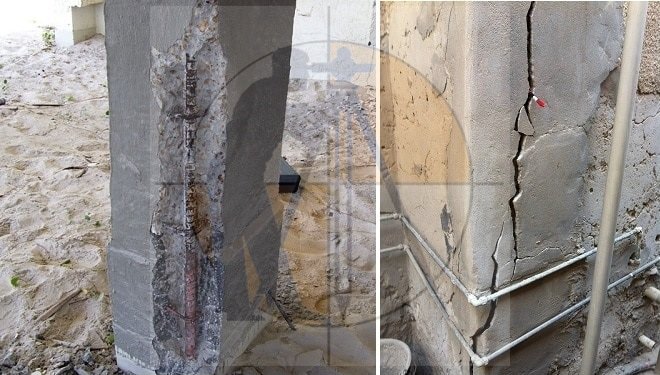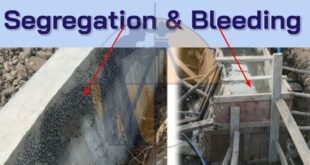Methods of Concrete Column Repair for Damages and Cracks

Repair of Concrete Columns for Cracks and Damages
Before starting the repair of a concrete column, the axial dead load, axial live load, horizontal load and its associated moments must be known.
Repairs to concrete columns can be divided into two categories. Surface or cosmetic repair only covers local deterioration and structural repair restores or strengthens the affected columns. If the deterioration does not significantly reduce the cross section, the conventional concrete repair can successfully be employed.
Methods of Concrete Column Repair for Damages and Cracks
Columns may be repaired by using one or more of the following methods:
Encasement or enlargement of the column cross section (jacketing).
Cathodic protection to stop reinforcing steel corrosion.
Re-alkalization of the reinforcing steel to stop corrosion.
Chloride extraction to retard the reinforcing steel corrosion.
Confinement using steel plate, carbon, or glass fiber materials.
Addition of shear collars to increase the shear capacity of intermediate floors.
Addition of a steel plate assembly to increase moment capacity.
Supplemental columns.
The application of a protection system to prevent future corrosion
Following parameters are important for the design and the execution of the column repair:
Learn More
How To Calculate The Height Of Any Buildings And An Objects Using With Theodolite
Unloading Columns
In those cases where the column deterioration is significant, unloading the column is usually required so that the entire cross section of the repaired column is capable of carrying the reintroduced design load. Without this unloading, the new repair will hardly carry any load.
Drying shrinkage of new material may further reduce this share of load. Unfortunately, it can be difficult and expensive to unload columns, especially in high-rise buildings. If the existing load on a column is not removed before the repair, the jacket will only provide confinement to the existing column. The percentage of direct load taken by jacket will be very small (less than 25 percent of the jacket strength).
If it is not possible to remove the load from the column, then a supplemental column system can provide an alternative method of support in combination with the repair of the existing column.
Redistribution of the Load
In case of corrosion of reinforcement and significant concrete deterioration, the load is redistributed in the structure before repair to a new pattern which must be considered while designing the repair. Even the adjoining members may have been affected by this redistribution.
Supplemental Reinforcing Steel
The column ties can not usually be disturbed during the repair as it may cause buckling of the longitudinal bars. Hence, the supplemental vertical bars may be placed outside the original cage with extra ties. When the supplemental bars are placed outside the tie bars, the column dimensions should be increased to provide adequate cover. Hairpin ties, usually of stainless steel, are used to laterally support the supplemental bars.
Other Post
-
Transition Curve In Highways – Purpose-Requirements-Example
-
How To Find The Coordinates Of Point P With The Help Of Point A & B
Concrete Removal
The removal of concrete within a column cage must only be done if the column is unloaded. Otherwise, the longitudinal bars may buckle and compression failure of column may take place.
Corroded Reinforcing Steel
It is not necessary to remove the corroded reinforcing bar with reduced cross-sectional area if the loss is supplemented with additional reinforcing bars. The lap length of such a splice must be provided corresponding to the area lost by corrosion to either side of the corroded portion of the reinforcing bar that is supplemented.
The partially corroded reinforcing bars that are left in place must be thoroughly cleaned by sandblasting to obtain bare metal. The bars with excessive corrosion must be replaced with fresh reinforcement having full laps on both sides.
Corroded Ties
The corroded ties can be replaced by adding stainless steel hairpin ties that are anchored into the concrete. It is often necessary to deposit extra material around columns to provide adequate cover over the supplemental ties.
Low-strength Concrete
Where the concrete strength is low, resulting in insufficient load-carrying capacity, several alternatives are available:
Shore the column and remove and replace the in-place concrete.
Shore the column and increase the size of the column to reduce the bending stresses, and to increase the confinement on already placed weak concrete.
Wrap the column with carbon- or glass-reinforced plastic.
Install a supplemental column.
Other Post
-
Calculate the self weight of R.C.C footings And Plinth Beam
-
Segregation & Bleeding in the Concrete | Causes, Effects And Remedies
-
Tendering Methods and Procedures in Construction.
 Surveying & Architects A unique platform of Civil Engineering
Surveying & Architects A unique platform of Civil Engineering

2 comments
Pingback: How To Calculate The Cement Bags Required For 2000 sq ft House - Surveying & Architects
Pingback: Quality Control Engineer Interview Question And Answer - Surveying & Architects